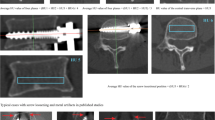Abstract
Purpose
Currently, the diagnosis of pedicle screw (PS) loosening is based on a subjectively assessed halo sign, that is, a radiolucent line around the implant wider than 1 mm in plain radiographs. We aimed at development and validation of a quantitative method to diagnose PS loosening on radiographs.
Methods
Between 11/2004 and 1/2010 36 consecutive patients treated with thoraco-lumbar spine fusion with PS instrumentation without PS loosening were compared with 37 other patients who developed a clinically manifesting PS loosening. Three different angles were measured and compared regarding their capability to discriminate the loosened PS over the postoperative course. The inter-observer invariance was tested and a receiver operating characteristics curve analysis was performed.
Results
The angle measured between the PS axis and the cranial endplate was significantly different between the early and all later postoperative images. The Spearman correlation coefficient for the measurements of two observers at each postoperative time point ranged between 0.89 at 2 weeks to 0.94 at 2 months and 1 year postoperative. The angle change of 1.9° between immediate postoperative and 6-month postoperative was 75 % sensitive and 89 % specific for the identification of loosened screws (AUC = 0.82).
Discussion
The angle between the PS axis and the cranial endplate showed good ability to change in PS loosening. A change of this angle of at least 2° had a relatively high sensitivity and specificity to diagnose screw loosening.


Similar content being viewed by others
References
Kothe R, Ruther W, Schneider E, Linke B (2004) Biomechanical analysis of transpedicular screw fixation in the subaxial cervical spine. Spine 29:1869–1875
Deckelmann S, Schwyn R, Van der Pol B, Windolf M, Heini PF, Benneker LM (2010) DensiProbe spine: a novel instrument for intraoperative measurement of bone density in transpedicular screw fixation. Spine. doi:10.1097/BRS.0b013e3181bc9470
Dickman CA, Fessler RG, MacMillan M, Haid RW (1992) Transpedicular screw-rod fixation of the lumbar spine: operative technique and outcome in 104 cases. J Neurosurg 77:860–870. doi:10.3171/jns.1992.77.6.0860
Esses SI, Sachs BL, Dreyzin V (1993) Complications associated with the technique of pedicle screw fixation. A selected survey of ABS members. Spine 18:2231–2238 discussion 2238–2239
Okuyama K, Abe E, Suzuki T, Tamura Y, Chiba M, Sato K (2000) Can insertional torque predict screw loosening and related failures? An in vivo study of pedicle screw fixation augmenting posterior lumbar interbody fusion. Spine 25:858–864
Wittenberg RH, Shea M, Swartz DE, Lee KS, White AA 3rd, Hayes WC (1991) Importance of bone mineral density in instrumented spine fusions. Spine 16:647–652
Nakashima H, Yukawa Y, Imagama S, Kanemura T, Kamiya M, Yanase M, Ito K, Machino M, Yoshida G, Ishikawa Y, Matsuyama Y, Ishiguro N, Kato F (2012) Complications of cervical pedicle screw fixation for non-traumatic lesions: a multicenter study of 84 patients. J Neurosurg Spine 16:238–247. doi:10.3171/2011.11.SPINE11102
Soini J, Laine T, Pohjolainen T, Hurri H, Alaranta H (1993) Spondylodesis augmented by transpedicular fixation in the treatment of olisthetic and degenerative conditions of the lumbar spine. Clin Orthop Relat Res pp 111–116
McAfee PC, Weiland DJ, Carlow JJ (1991) Survivorship analysis of pedicle spinal instrumentation. Spine 16:S422–S427
Yuan HA, Garfin SR, Dickman CA, Mardjetko SM (1994) A historical cohort study of pedicle screw fixation in thoracic, lumbar, and sacral spinal fusions. Spine 19:2279S–2296S
Ohlin A, Karlsson M, Duppe H, Hasserius R, Redlund-Johnell I (1994) Complications after transpedicular stabilization of the spine. A survivorship analysis of 163 cases. Spine 19:2774–2779
Pihlajamaki H, Myllynen P, Bostman O (1997) Complications of transpedicular lumbosacral fixation for non-traumatic disorders. J Bone Jt Surg Br 79:183–189
Wu JC, Huang WC, Tsai HW, Ko CC, Wu CL, Tu TH, Cheng H (2011) Pedicle screw loosening in dynamic stabilization: incidence, risk, and outcome in 126 patients. Neurosurg Focus 31:E9. doi:10.3171/2011.7.FOCUS11125
Wu ZX, Gong FT, Liu L, Ma ZS, Zhang Y, Zhao X, Yang M, Lei W, Sang HX (2012) A comparative study on screw loosening in osteoporotic lumbar spine fusion between expandable and conventional pedicle screws. Arch Orthop Trauma Surg 132:471–476. doi:10.1007/s00402-011-1439-6
Schatzker J, Horne JG, Sumner-Smith G (1975) The effect of movement on the holding power of screws in bone. Clin Orthop Relat Res, pp 257–262
Sanden B, Olerud C, Petren-Mallmin M, Johansson C, Larsson S (2004) The significance of radiolucent zones surrounding pedicle screws. Definition of screw loosening in spinal instrumentation. J Bone Jt Surg Br 86:457–461
StatTools (July 2012) http://www.stattools.net/ICC_Exp.php. StatTools
Tokuhashi Y, Matsuzaki H, Oda H, Uei H (2008) Clinical course and significance of the clear zone around the pedicle screws in the lumbar degenerative disease. Spine 33:903–908. doi:10.1097/BRS.0b013e31816b1eff
Conflict of interest
None.
Author information
Authors and Affiliations
Corresponding author
Rights and permissions
About this article
Cite this article
Aghayev, E., Zullig, N., Diel, P. et al. Development and validation of a quantitative method to assess pedicle screw loosening in posterior spine instrumentation on plain radiographs. Eur Spine J 23, 689–694 (2014). https://doi.org/10.1007/s00586-013-3080-2
Received:
Revised:
Accepted:
Published:
Issue Date:
DOI: https://doi.org/10.1007/s00586-013-3080-2




